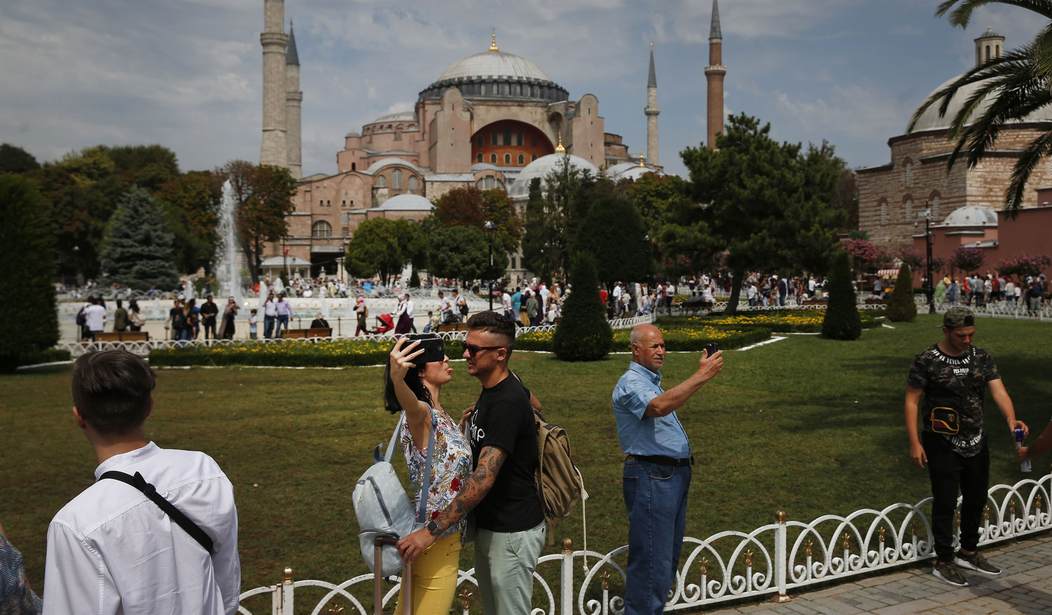One little-noted effort Donald Trump took to Make America Great Again was a Dec. 2020 executive order combating the aggressive ugliness of the modern American public square. That effort is worth reviving. It is useful to recall that on this day in the year 537, a grand structure was inaugurated that still stands as a model of what public buildings can and should be.
Trump’s executive order noted that “societies have long recognized the importance of beautiful public architecture. Ancient Greek and Roman public buildings were designed to be sturdy and useful, and also to beautify public spaces and inspire civic pride.” Old Joe Biden’s regime, of course, deep-sixed that idea in a hurry; apparently, beautiful and inspiring public buildings are racist or transphobic or something. Civic pride is not something this socialist internationalist regime wants us to have.
Saner societies had a sounder understanding of the importance of beauty. In 532, the Roman Emperor Justinian, determined to make his empire great again, ordered work begun on a grand new cathedral to adorn his capital city, Constantinople, which would outshine all cathedrals constructed before or since. Working at truly astonishing speed, Justinian’s craftsmen completed this new cathedral, Hagia Sophia (“Holy Wisdom”), in only five years. As "Empire of God: How the Byzantines Saved Civilization" details, when he entered the church for the first time as it was nearing completion, Justinian is said to have exclaimed, “Glory to God that I have been judged worthy of accomplishing such a work as this. O Solomon! I have outdone you!” He believed that his new cathedral was even greater than the Temple of Solomon that had once stood in Jerusalem.
Justinian’s grand building has survived for nearly fifteen hundred years now. It stood for nearly a millennium as the largest and grandest church in the Christian world and was widely imitated. Saint Mark’s Basilica in Venice bears numerous points of resemblance to Hagia Sophia and is filled with icons and other sacred objects taken from Constantinople by the crusaders in 1204. The Dome of the Rock on the Temple Mount in Jerusalem, built in 691, is also largely patterned after Hagia Sophia, as is the Umayyad Mosque in Damascus, the Suleyman Pasha Mosque in Cairo, and several mosques in present-day Istanbul itself. Even the nineteenth-century Great Synagogue of Florence sports a dome that shows signs of Hagia Sophia’s influence.
Hagia Sophia itself remains as potent a symbol fifteen hundred years after its construction as it was on the day it was consecrated. What exactly it symbolizes, however, has shifted throughout history. Justinian intended it to show forth the truth and triumph of Christianity and the grandeur of his empire. Similarly, when Sultan Mehmed summoned a muezzin and had him proclaim the shahada, the Islamic profession of faith, in the conquered church on May 29, 1453, as the blood of Christians he and his men had just slaughtered ran in the aisles, he intended the newly converted mosque to stand as a symbol of the triumph of Islam over Christianity and the superiority of the religion of Muhammad over that of Christ.
Nearly five hundred years later, in 1935, the founder of secular Turkey, Kemal Ataturk, also eyed the great building for its symbolic value. He converted the “Aya Sofya mosque” (the name of the Cathedral of Holy Wisdom carried over into a new language and new religion in which it became just that: a name, bereft of meaning) into a museum, intending it to demonstrate the triumph of secularism and rationalism over religious superstitions both Christian and Islamic, particularly Islamic. “Islam,” said Ataturk, “this theology of an immoral Arab, is a dead thing.” His museum was meant to demonstrate that all that religious mumbo-jumbo was a dead thing, now laid out and preserved and displayed in what once had been the greatest manifestation of Christian religiosity in the entire world.
Then in 2020, when Erdogan dismayed the world by converting Hagia Sophia into a functioning mosque once again, he also had an eye upon the building’s symbolic value. Erdogan had spent nearly two decades systematically dismantling Kemalist secularism, building Islamic schools and mosques at a rapid clip, restoring a strong Islamic component to Turkish education, and repeatedly railing against secularism. His restoration of “Aya Sofya” as a mosque epitomized his entire program of the restoration of Islam as the centerpiece of Turkish society. Erdogan intended the restored mosque to symbolize Islam’s new triumph over secularism as well as its old one over Christianity, and his message resonated with a large segment of his people.
Hagia Sophia is still a commanding presence in the city that is now known as Istanbul. Justinian intended the beauty and magnificence of the structure to be an integral part of his plan to make Constantinople the greatest city in the world and the capital not just of his empire, but of the civilized world itself. As such, it was of supreme importance that Hagia Sophia not be an eyesore or at odds with the landscape in which it was placed. The breathtaking beauty of the building was considered a reflection of the beauty of the heavenly realms and of God himself.
Related: How the Byzantines Saved Civilization
Nowadays, our society recognizes no god but our own desires, and our public buildings are ruthlessly utilitarian. Brutalist structures are often straight boxes, bereft entirely of anything upon which the eye can rest, much less feast. In keeping with their name, many seem to be deliberately offensive, with jutting angles and uneven lines that look deliberately designed to render one disoriented and off-balance. Even many churches seem to compete with one another in ugliness.
Were a modern-day Justinian to build a Hagia Sophia today, the result would certainly differ radically from what Justinian’s architects and builders constructed. This is not just because our world is so very different from sixth-century Constantinople, or because the faith that imbued that structure has largely vanished from human societies, but because the prevailing philosophy of architecture today has no patience for structures of that kind. The new cathedral, or whatever it would be, would be a monstrosity of steel, glass, and geometric oddities.
Some object to brutalist architecture over its demonstration of contempt for the people who will use such buildings as well as for the surrounding landscape. Justinian, by contrast, understood the power of beauty and of grandeur, and the solace that they offered to the human spirit. Many people today are far too sophisticated for all that.










Join the conversation as a VIP Member